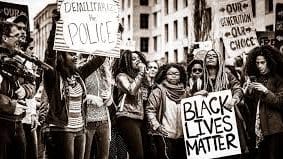Protests that have erupted across America over the custodial killing of George Floyd have not only ripped open American racism, but have also forced journalism to ask a central question — what is objectivity?
This is true, especially for black journalists for whom reporting on police brutality against people of colour isn’t just any story, it’s one that hits very close to home.
In a piece about how America’s newsrooms are witnessing internal revolts while reporting on the chaos outside, New York Times’ columnist Ben Smith talked about how black journalists, who have been out on the streets covering these stories since 2014, return to their newsrooms and cannot see their jobs in the same light again. Witnessing the “brutality of a white power structure toward its poor black citizens up close”, is not just a nut graph in their articles, it’s a real experience that has changed them at an organic level.
Over the past few weeks, many journalists have recounted episodes of policemen racially profiling them, regardless of whether they clearly identified themselves as ‘press’. Prominent among them was CNN‘s Omar Jimenez, who was arrested while broadcasting live from a protest site in Minneapolis, the epicentre of the current wave of Black Lives Matter protests.
Also read: When Black lives are valued, property becomes worth saving
Facts versus truth
What Smith pointed out is something most journalists have grappled with in some shape and form in recent times — reporting objectively versus reporting what they saw.
Objectivity is the basic tenet of journalism; it’s drilled into you from the very beginning. If you do happen to forget it, editors vetting your story will push you to chase the ‘other’ side for a comment, even if that ends up being a ‘no comment’.
Instead of presenting a single point of view, it’s your job to tell all sides of the story, so readers are equipped with all the facts to make an informed decision.
But US President Donald Trump’s tirades against news outlets have complicated the issue for journalists, forcing them to ask fundamental questions about their profession. Trump personifies a large part of the problem, but by no means is he the one to create it.
If he doesn’t like something, his go-to buzz word is ‘fake news‘. This creates a different problem for publications that want to call out his factual inaccuracies and wrongdoings in office. In fact, if you even ask a tough question at a press conference, he might call out your race — “Don’t ask me, ask China“. Remember when he mocked a disabled reporter, and then denied ever doing so.
Any reporter worth their salt would report on what Trump said. Verbatim. His controversial, and often factually incorrect, statements made for big news initially, but over time, it stopped being surprising or newsworthy.
This is where the problem of ‘both side-ism’ comes in. Must every claim of the President be reported in absolute terms of objectivity?
Newspapers got around this dilemma by fact-checking everything Trump says. CNN’s Fareed Zakaria called out the President’s old lie about the size of the crowd at his inaugural ceremony. A New York Times report published last week analysed Trump’s Twitter feed for a week and found that a third of the posts contained falsehoods or murky accusations, while the Washington Post painstakingly fact-checked the 18,000 false or misleading claims he has made in his last 1,710 days of office.
One of the oldest cliches in journalism is ‘speaking truth to power’ , as is the quote “The job of the newspaper is to comfort the afflicted and afflict the comfortable”.
But when you have a President like Trump, and a senator like Tom Cotton, news publications run the risk of uncritically offering them a platform for their views versus their job of questioning them. The solution for this dilemma of ‘both side-ism’, according to New York Times executive editor Dean Baquet is something called “sophisticated true objectivity.” To avoid the temptation of labeling and cheap analysis by calling something a lie, Baquet argues that we must instead engage in deep reporting and let someone else prove that it is a lie. For young journalists being forged in the Black Lives Matter fire though, this might no longer be enough.
Views are personal.
Also read: Two books, TV shows and Trump: The story of how Black rage returned in America







By the standards of objectivity most journalists and media publications will fall flat in our country. Is NDTV objective? Is Republic TV objective? Is The Telegraph objective? Is The Wire objective? I could go on and on without even reaching Samana or National Herald. People now read or watch these publications and channels because either they are a part of the echo chamber or, like me, for entertainment. Objectivity is not we are likely to get here.
So, what should the journalists do? It is not clear what your opinion on this is? Yes journalists are facing this dilemma, but what? in you opinion should they do? You have not expressed your views on this, so really don’t know what you are trying say. This is just a random observation.